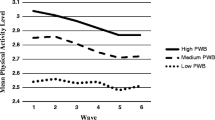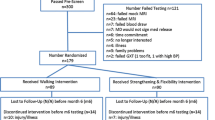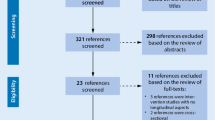We examined the effects of two physical activity modes on depressive symptoms over a 5-year period among older adults and change in physical self-esteem as a mediator of changes in depressive symptoms. Formerly sedentary, older adults (N = 174) were randomly assigned into 6-month conditions of either walking or low-intensity resistance/flexibility training. Depressive symptoms and physical self-esteem were measured before and after the 6-month intervention, and 12 and 60 months after intervention initiation. Depressive symptoms scores were decreased immediately after the intervention, followed by a sustained reduction for 12 and 60 months after intervention initiation; there was no differential pattern of change between the physical activity modes. Change in physical self-esteem predicted change in depressive symptoms. This study supports the effectiveness of an exercise intervention for the sustained reduction of depressive symptoms among sedentary older adults and physical self-esteem as a potential mediator of this effect.


Similar content being viewed by others
REFERENCES
Arbuckle, J. L. (1996). Full information estimation in the presence of incomplete data. In Marcoulides, G. A., and Schumacker, R. E. (Eds.), Advanced Structural Equation Modeling: Issues and Techniques, Lawrence Erlbaum, Mahwah, NJ, pp. 243–277.
Babyak, M., Blumenthal, J. A., Herman, S., Khatri, P., Doraiswamy, M., Moore, K., Craighead, W. E., Baldewicz, T. T., and Krishnan, K. R. (2000). Exercise treatment for major depression: Maintenance of therapeutic benefit at 10 months. Psychosom. Med. 62: 633–638.
Baumeister, R. F. (1993). Understanding the inner nature of self-esteem. In Baumeister, R. F. (Ed.), Self-Esteem: The Puzzle of Low Self-Regard, Plenum, New York, pp. 201–218.
Baumeister, R. F., Campbell, J. D., Krueger, J. I., and Vohs, K. D. (2003). Does high self-esteem cause better performance, interpersonal success, happiness, or healthier lifestyles? Psychol. Sci. Pub. Inter. 4:1–44.
Begg, C. B., and Iglewicz, B. (1980). A treatment allocation procedure for sequential clinical trials. Biometrics 36: 81–90.
Bentler, P. M. (1990). Comparative fit indices in structural models. Psychol. Bull. 107: 238–246.
Bentler, P. M., and Bonett, D. G. (1980). Significance tests and goodness of fit in the analysis of covariance structures. Psychol. Bull. 88: 588–606.
Blair, S. N., and Connelly, J. C. (1996). How much physical activity should we do? The case for moderate amounts and intensities of physical activity. Res. Q. Sport. Exerc. 67: 193–205.
Blumenthal, J. A., Babyak, M. A., Moore, K. E., Craighead, Plenum, W. A., Herman, S., Khatri, P., Waugh, R., Napolitano, M. A., Forman, L. M., Appelbaum, M., Doraiswamy, P. M., and Krishnan, K. R. (1999). Effects of exercise training on older adults with major depression. Arch. Intern. Med. 159: 2349–2356.
Boileau, R., McAuley, E., Demetriou, D., Devabhaktuni, N. K., Dykstra, G. L., Katula, J., Nelson, J., Pascale, A., Pena, M., and Talbot, H. (1999). Aerobic exercise training and cardiorespiratory fitness in older adults: A randomized controlled trial. J. Aging Physical Activity 7: 374–385.
Bollen, K. A. (1989). Structural Equations with Latent Variables, Wiley, New York, NY.
Borg, G. (1998). Borg's Perceived Exertion and Pain Scales, Human Kinetics, Champaign, IL.
Broose, A. L., Sheets, E. S., Lett, H. S., and Blumenthal, J. A. (2002). Exercise and the treatment of clinical depression in adults: Recent findings and future directions. Sports. Med. 32: 741–760.
Browne, M. W., and Cudeck, R. (1993). Alternative ways of assessing model fit. In Bollen, K. A., and Long, J. S. (Eds.), Testing Structural Equation Models, Sage, Newbury Park, CA, pp. 136–162.
Cutrona, C. E., and Russell, D. W. (1987). The provisions of social relationships and adaptations to stress. In Jones, W. H., and Perleman, D. (Eds.), Advances in Personal Relationships, JAI Press, Greenwich, pp. 37–67.
Diener, E. (1984). Subjective well-being. Psychol. Bull. 95: 542–575.
Dishman, R. K. (1997). Brain monoamines, exercise, and behavioral stress: Animal models. Med. Sci. Sports Exerc. 29: 63–74.
Duncan, T. E., Duncan, S. C., Strycker, L. A., Li, F., and Alpert, A. (1999). An Introduction to Latent Variable Growth Curve Modeling, Lawrence Erlbaum, Nahwah, NJ.
Dunn, A. L., Trivedi, M. H., and O'Neal, H. A. (2001). Physical activity dose-response effects on outcomes of depression and anxiety. Med. Sci. Sports Exerc. 33: S587–S597.
Enders, C. K. (2002). A primer of maximum likelihood algorithms available for use with missing data. Struct. Equat. Model. 8: 128–141.
Enders, C. K., and Bandalos, D. L. (2001). The relative performance of full information maximum likelihood estimation for missing data in structural equation models. Struct. Equat. Model. 8: 430–457.
Fox, K. R. (1990). The Physical Self-Perception Manual, Office of Health Promotion, Northern Illinois University, Dekalb, IL.
Fox, K. R. (2000). Self-esteem, self-perceptions and exercise. Int. J. Sport Psychol. 31: 228–240.
Hu, L., and Bentler, P. M. (1999). Cutoff criteria for fit indexes in covariance structure analysis: Conventional criteria versus new alternatives. Struct. Equat. Model. 6: 1–55.
Hyer, L., and Blount, J. (1984). Concurrent and discriminant validities of the Geriatric Depression Scale with older psychiatric inpatients. Psychol. Rep. 54: 611–616.
Jöreskog, K. G., and Sörbom, D. (1996). LISREL 8: User's reference guide, Scientific Software International, Chicago, IL.
Lance, C. E., Vandenberg, R. J., and Self, R. M. (2000). Latent growth models of individual change: The case of newcomer adjustment. Organ. Behav. Human Decis. Process. 83: 107–140.
Larsson, L., Grimby, G., and Karlsson, J. (1979). Muscle strength and speed of movement in relation to age and muscle morphology. J. Appl. Physiol. 46: 451–456.
Li, F., Duncan, T., Duncan, S., McAuley, E., et al. (2001). Enhancing psychological well-being of elderly individuals through tai-chi exercise. Struct. Equat. Model. 8: 53–83.
Li, F., Harmer, P., Chaumeton, N. R., Duncan, T. E., et al. (2002). Tai Chi as a means to enhance self-esteem: A randomized controlled trial. J. Appl. Gerontol. 21: 70–89.
Mather, A. S., Rodriguez, C., Guthrie, M. F., McHarg, A. M., M., Reid, I. C., and McMurdo, M. E. (2002). Effects of exercise on depressive symptoms in older adults with poorly responsive depressive disorder. Brit. J. Psychiatry 180: 411–415.
McAuley, E., Kramer, A. F., and Colcombe, S. J. (2004). Cardiovascular fitness and neurocognitive function in older adults: A brief review. Brain, Behav. Immun. 18: 214–220.
McAuley, E., Katula, J., Mihalko, S. L., Blissmer, B., et al. (1999). Mode of physical activity and self-efficacy in older adults: A latent growth curve analysis. J. Gerontol. B Psychol. Sci. Soc. Sci. 54: P283–P292.
McMurdo, M. E. T., and Burnett, L. (1992). Randomized controlled trial of exercise in the elderly. Gerontology 38: 292–298.
McNeil, J. K., LeBlanc, E. M., and Joyner, M. (1992). The effect of exercise on depressive symptoms in the moderately depressed elderly. Psychol. Aging 6: 487–488.
Meredith, W., and Tisak, J. (1990). Latent curve analysis. Psychometrika 55: 107–122.
National Institute of Aging (2002). Older Americans 2000: Key Indicators of Well-Being. (Federal Interagency Forum on Aging-Related Statistics), US Government Printing Office, Washington, DC.
O'Connor, P. J., Aenchbacher, L. E., and Dishman, R. K. (1993). Physical activity and depression in the elderly. J. Aging Physical Activity 1: 34–58.
O'Neal, H. A., Dunn, A. L., and Martinsen, E. W. (2000). Depression and exercise. Int. J. Sport Psychol. 31: 110–135.
Penninx, B. W., Guralnik, J. M., Ferrucci, L., Simonsick, E. M., Deeg, D. J., and Wallace, R. B. (1998). Depressive symptoms and physical decline in community-dwelling older persons. JAMA 279: 1720–1726.
Penninx, B. W., Rejeski, W. J., Pandya, J., Miller, M. E., et al. (2002). Exercise and depressive symptoms: A comparison of aerobic and resistance exercise effects on emotional and physical function in older persons with high and low depressive symptomatology. J. Gerontol. B Psychol. Sci. Soc. Sci. 57: P124–P132.
Pfeiffer, E. (1975). A Short Portable Mental Status Questionnaire for the assessment of organic brain deficit in elderly patients. J. Am. Geriatr. Soc. 23: 433–441.
Rosenberg, M., Schooler, C., Schoenbach, C., and Rosenberg, F. (1995). Global self-esteem and specific self-esteem: Different concepts, different outcomes. Am. Sociol. Rev. 60: 141–156.
Singh, N. A., Clements, K. M., and Fiatarone, M. A. (1997). A randomized controlled trial of progressive resistance training in depressed elders. J. Gerontol. A Med. Sci. 52: M27–M35.
Singh, N. A., Clements, K. M., and Singh, M. A. F. (2001). The efficacy of exercise as a long-term antidepressant in elderly subjects: A randomized controlled trial. J. Gerontol. A Med. Sci. 56: M497–M504.
Sonstroem, R. J. (1997). Physical activity and self-esteem. In Morgan, W. P. (Ed.), Physical Activity and Mental Health, Taylor and Francis, Washington, DC, pp. 128–143.
Sonstroem, R. J., and Morgan, W. P. (1989). Exercise and self-esteem: Rationale and model. Med. Sci. Sports Exerc. 21: 329–337.
Sonstroem, R. J., and Potts, S. A. (1996). Life adjustment correlates of physical self-concepts. Med. Sci. Sports Exerc. 28: 619–625.
Strawbridge, W. J., Deleger, S., Roberts, R. E., and Kaplan, G. A. (2002). Physical activity reduces the risk of subsequent depression for older adults. Am. J. Epidemiol. 156: 328–334.
Willett, J. B., and Sayer, A. G. (1994). Using covariance structure analysis to detect correlates and predictors of individual change over time. Psychol. Bull. 116: 363–381.
Wothke, W. (2000). Longitudinal and multigroup modeling with missing data. In Little, T. D., Schnabel, K. U., and Baumert, J. (Eds.), Modeling Longitudinal and Multilevel Data: Practical Issues, Applied Approaches, and Specific Examples, Lawrence Erlbaum, Mahwah, NJ, pp. 219–240.
Yesavage, J. A., Brink, T. L., Rose, T. L., Lum, O., Huang, V., Adey, M., and Leirer, V.O. (1982). Development and validation of a geriatric depression screening scale: A preliminary report. J. Psychiatric Res. 17: 37–49.
ACKNOWLEDGMENT
Funding for this study was provided by the National Institute on Aging (Grant 2RO1 AG 12113).
Author information
Authors and Affiliations
Corresponding author
Rights and permissions
About this article
Cite this article
Motl, R.W., Konopack, J.F., McAuley, E. et al. Depressive Symptoms Among Older Adults: Long-Term Reduction After a Physical Activity Intervention. J Behav Med 28, 385–394 (2005). https://doi.org/10.1007/s10865-005-9005-5
Published:
Issue Date:
DOI: https://doi.org/10.1007/s10865-005-9005-5




